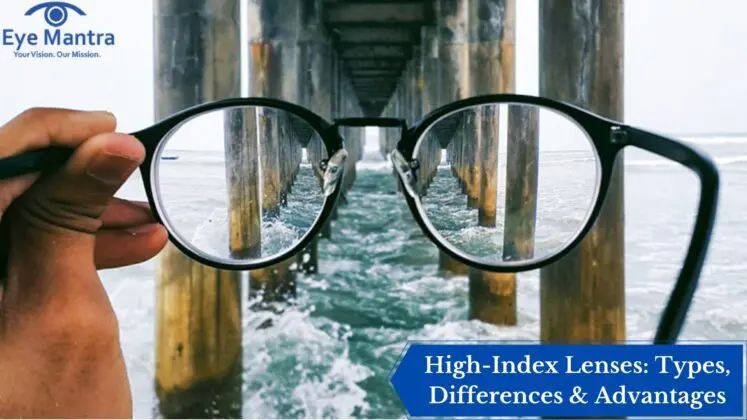
High-Index lenses are designed flexibly to bend light and may be the right choice for you if you are searching for thinner and lighter lenses. Doctors will recommend you this kind of lens in case you have a strong prescription for eyeglasses for farsightedness, astigmatism, or nearsightedness. These lenses are specifically designed to perform flexibly and bend light to correct the vision of those who require to wear prescription eyeglasses. Therefore, the lenses are thin and light, making them more comfortable for daily use.
Typical prescription lenses designed to correct vision for those who suffer from near or far-sightedness or astigmatism are thick and bulky and can make the individual wearer self-conscious about their appearance. These lenses remedy those with powerful prescription lenses by offering versatility in the style of fitted frames.
Contents
There are three major differences between the high index and regular lenses:
High-index lenses require less material for their design, this makes them much lighter in weight than regular lenses – which, on the contrary, are made up of heavier materials such as glass or plastic. The thickness (and heaviness) of the lens will depend upon the strongness of the necessary prescription of the corrective lens. Conversely, a weaker prescription lens (derive from light materials), would not be able to provide much of a benefit in case used with high-index materials.
High-index lenses are relatively expensive keeping in mind the technological advancements invested in them. It is by default that the higher the index, the higher will be the price. The stronger the corrective prescription for lenses, the higher the discount in the lens thickness and weight of high-index materials utilized. This will directly affect the overall price of the high-index lenses chosen. The advantages that high-index lenses provide, however, may make the cost a genuine matter of perspective.
The thickness of a lens plays a role in style and comfort as well as frame compatibility. Thick lenses can distort appearances and may prove problematic while fitting to the chosen frame style. The outer edge is the thickest section of the lens. The frame must be fitted in such a way that the majority of the outer edge is disguised. Conversely, in case of frames are chosen to compliment thicker lenses, they might not be able to support each lens correctly, making the overall appearance of the eyeglasses odd.
The refraction index helps in determining how well an eyeglass lens would be able to bend the light. This feature will depend upon how quickly light is able to pass through the material. The more refracts the light, the slower the speed of light through the material. In other words, the index of refraction increases as a lens bends light more effectively.
A lens is high-index when the refractive index exceeds that of plastic or glass. There are various refractive indices of high-index lenses. The normal range can be considered from 1.53 to 1.74. In cases where the refractive index is 1.70 or more, the lens is usually at least 50 percent thinner if compared to a conventional plastic lens.
A number of modern lens types with high-index material are available. The following are the most common lens type:
There are also available different options you can generally apply to your high-index lenses. These coating may include the below-mentioned:
AR Coating: all lens materials block the way for some lights to pass through the lens. This light reflects back from the surface of the lens, leading to distractions and, therefore, reduces the clarity of night vision. Conventional glass or plastic lenses reflect around 8 percent of the light that otherwise would reach the eye. High-index lenses reflect about 50 percent more light if compared to conventional glass or plastic lenses.
For experiencing the best vision it would be suggested to have an anti-reflective lens coating (AR coating) applied to high-index lenses. 99.5 percent of light to the eye for optimum vision is transmitted by AR-coated high-index lenses. They visually eliminate lens reflections which makes high-index lenses appear almost invisible so that people see your eyes and not your lenses.
There are various important benefits of high-index lenses:
These lenses are also more affordable to the masses as a result of gaining recent popularity, with new innovations helping reduce the cost.
Opting for the right high-index lens is not as complicated as some might imagine. These days there are various options for high-performing lenses to purchase and as popularity (and market awareness) increases, the price of the lenses decreases.
Consider the following things while deciding whether to buy high-index lenses for yourself or a loved one:
The best way to treat your eyes is to visit your eye care professional and get your eyes checked regularly. He will be able to assess the best method of treatment for your eye ailment.
Visit our website Eyemantra.
To book an appointment call at +91-8851044355. Or mail us at eyemantra1@gmail.com.
Our other services include Retina Surgery, Specs Removal, Cataract Surgery, and many more.